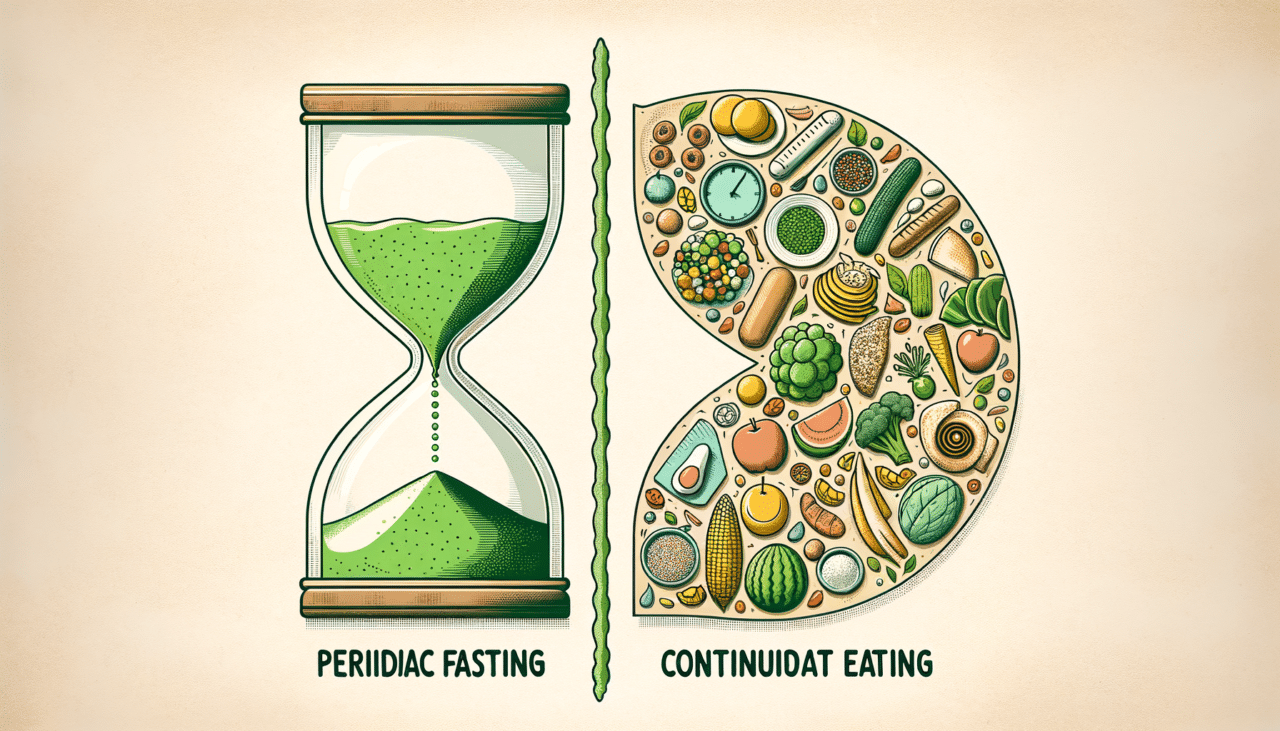Introduction
In the realm of nutrition and weight management, two popular dietary approaches have gained significant attention: the Periodic Fasting Diet and the Continuous Eating Diet. Each offers unique benefits and challenges, appealing to different lifestyles and health goals. This article delves into the specifics of these dietary strategies, providing a detailed comparison to help you determine which approach might suit your needs best.
Understanding Periodic Fasting Diet
Characteristics:
-
Intermittent Fasting Structures: The Periodic Fasting Diet typically involves various fasting schedules, such as the 16/8 method (16 hours of fasting, 8 hours of eating), the 5:2 method (eating normally for 5 days, reducing calorie intake for 2 days), or alternate-day fasting.
-
Focus on Time-Restricted Eating: This diet emphasizes eating within a specific time window, allowing the body to spend more time in a fasted state, which can promote fat metabolism.
-
Potential Health Benefits: Research suggests that periodic fasting may improve metabolic health, enhance brain function, and promote longevity. It may also aid in weight loss by reducing calorie intake over time.
-
Flexibility in Food Choices: While the timing of meals is restricted, there are generally no specific limitations on what can be consumed during eating periods, making it adaptable to various dietary preferences.
-
Mental and Physical Adaptation: Some individuals may experience initial challenges, such as hunger and irritability, as the body adapts to new eating patterns.
Exploring Continuous Eating Diet
Characteristics:
-
Regular Meal Consumption: The Continuous Eating Diet encourages eating at regular intervals throughout the day, typically including three main meals and snacks.
-
Steady Energy Levels: By providing consistent energy intake, this diet aims to maintain stable blood sugar levels and prevent energy crashes.
-
Focused on Portion Control: Success with this diet often involves monitoring portion sizes and making mindful food choices to avoid overeating and ensure nutritional balance.
-
Supports Digestive Health: Regular meals can support digestive efficiency, as the body is accustomed to processing food at consistent intervals.
-
Potential for Overeating: Without careful planning, this approach may lead to excessive calorie consumption, especially if high-calorie snacks are frequently included.
Comparative Table: Periodic Fasting Diet vs. Continuous Eating Diet
| Criteria | Periodic Fasting Diet | Continuous Eating Diet |
|---|---|---|
| Meal Frequency | Limited to specific time windows | Regular intervals throughout the day |
| Caloric Intake | Often lower due to restricted eating times | Potentially higher if not monitored |
| Metabolic Health Benefits | May improve metabolism and promote fat loss | Can maintain stable blood sugar levels |
| Flexibility with Food Choices | Flexible during eating periods | Requires careful portion control |
| Adaptation Period | Initial adaptation may cause discomfort | Generally easier adaptation |
| Potential for Weight Loss | High, due to reduced calorie intake over time | Moderate, depends on portion control |
| Impact on Energy Levels | May fluctuate, especially during fasting periods | Typically stable with regular meals |
| Longevity and Health Benefits | Potentially enhances longevity and cognitive health | Offers steady nutrient intake |
| Digestive Health | May improve due to fasting periods | Supports regular digestive function |
| Sustainability | Depends on individual lifestyle and preferences | Generally sustainable with proper planning |
Conclusion
Both the Periodic Fasting Diet and the Continuous Eating Diet offer distinct approaches to nutrition and weight management. The best choice depends on personal health goals, lifestyle, and how each individual responds to different eating patterns. While periodic fasting may enhance metabolic health and promote weight loss, continuous eating can maintain energy levels and support digestive health. By considering the characteristics and potential benefits of each diet, you can make an informed decision tailored to your unique needs.
By understanding these dietary strategies, you can embark on a nutritional journey that aligns with your lifestyle and health objectives. Whether you opt for periodic fasting or continuous eating, the key lies in mindful eating and consistency to achieve lasting results.

Comments (0)
There are no comments here yet, you can be the first!